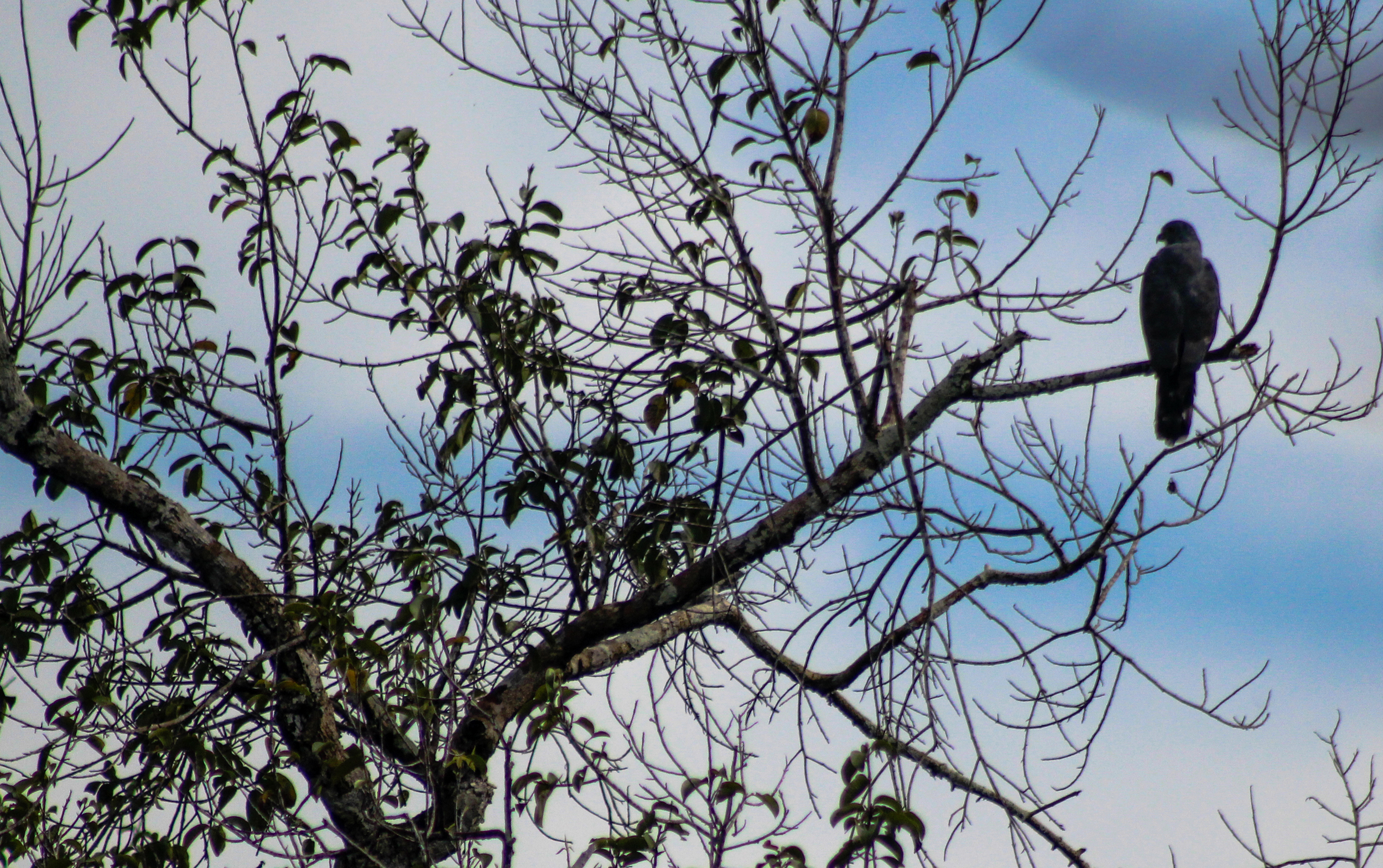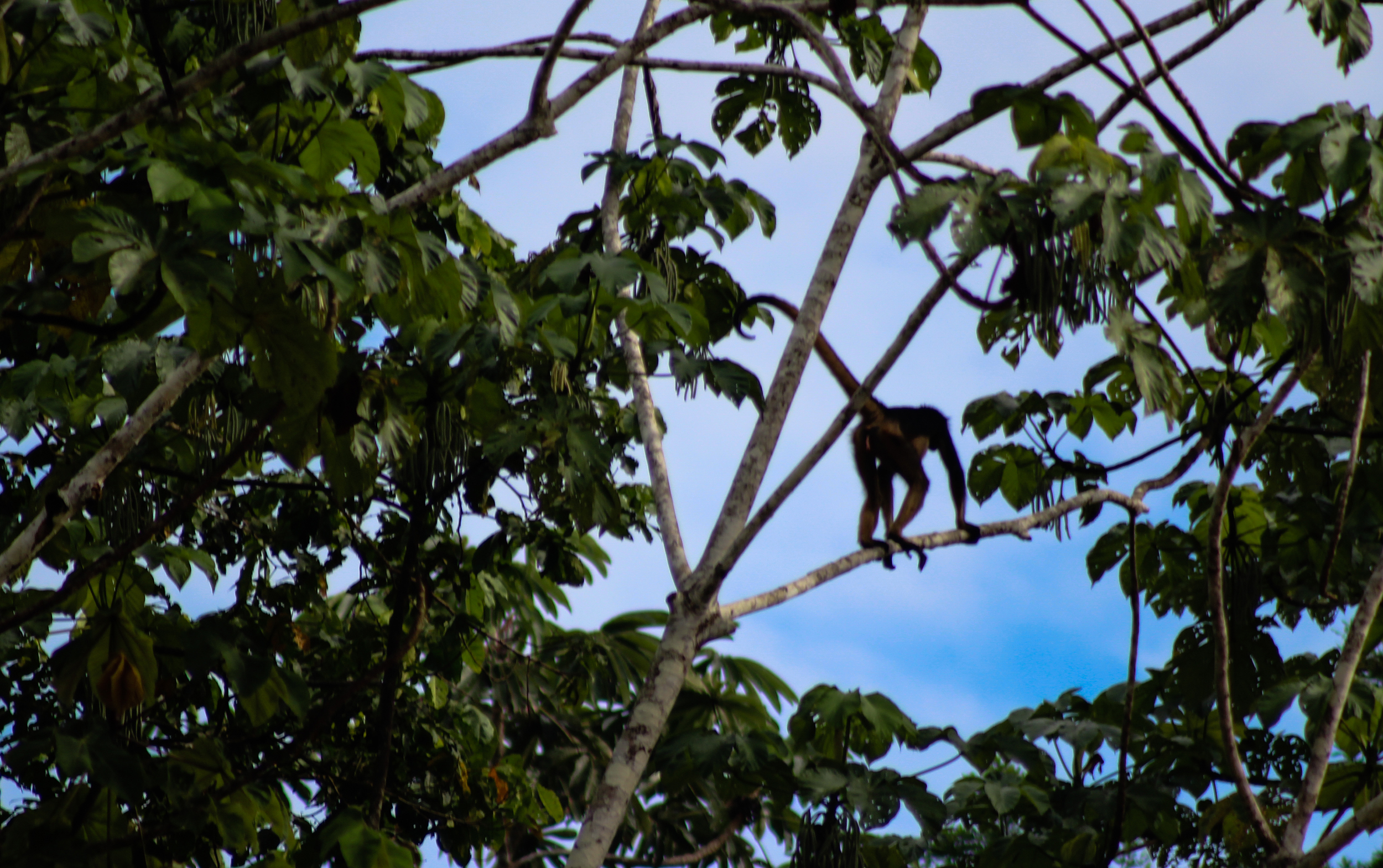Sanctuary, laboratory ... lifeboat
The Tiputini Biodiversity Station is home to the widest variety of plants, animals and insects in South America – maybe even the world
The Tiputini Biodiversity Station will probably survive, but will come to be this tiny little island of habitat in an area that looks like the rest of oil country in eastern Ecuador.
– Kelly Swing
By Maria Silva
The view of the Tiputini River from the landing site at the entrance to the research station. Yasuni National Park lies across the river. (Maria silva)
The Amazon is the largest rainforest in the world. Within it are smaller rainforests, and each has a unique ecosystem. This enormous, shady river basin contains lush vegetation, many varieties of edible fruits and medicinal plants, and some of the largest and most deadly predators on the planet. The biodiversity gives researchers a broad range of topics to study.
Located in Ecuador’s Amazonas Oriente region, the Tiputini research station is set in the most biodiverse place in the most biodiverse region of South America, and maybe the Earth. Established in 1995, it lies on the north bank of the Tiputini River across from Yasuni National Park.
The Tiputini Biodiversity Station is a joint venture of Universidad San Francisco de Quito and Boston University, and funding from the latter makes the project possible. But it was the work of founding director Kelly Swing, a professor of ecology at USFQ and an adjunct professor at Boston U, that determined the location.
“BU wanted to have a place that could receive students participating in its newly developed field biology program,” Swing says in his office at USFQ, in the posh Quito suburb of Cumbaya. “They also wanted to establish connections with an active portion of the scientific research community."
Today, the station belongs to an oil concession called Block 14, an area being prospected by Andes Petroleum Ecuador Ltd., a company controlled by two state-owned Chinese oil corporations.
“When I chose that spot, the closest oil operation was 25 kilometres away,” Swing says. “I would have hoped for it to be 100 kilometres away or more. Now we have an oil well within seven kilometres of our station.”
Hosting students and scientists from all over the world, the station allows researchers to study a rich variety of flora and fauna.
Forest magic
In Tiputini, the trees can reach as high as 20 metres, and you barely glimpse the blue sky through the forest canopy. You hear but you don’t often see the birds that soar high above the forest, and the howler monkeys that live in the treetops
Early morning feels like mid-evening, because of the shadows cast by the hundreds of different types of trees.
Hordes of insects crawl around your feet and buzz about your head.
Traditionally, Tiputini has been a base for biological research but climate change has opened it up to new fields. (Maria Silva)
On the equator, in a dense forest, it’s a strange place, where you can feel wet, dry, chilly and hot all at the same time. The mud never seems to dry out into solid ground, and the rain is as sudden and violent as the noises in the forest. The thunder can be heard from kilometres away, as can the sound of pouring rain creeping toward you.
The continuous sounds of insects, birds and monkeys create a cacophony of echoes that rush through the trees, stopping suddenly as the rain thuds onto the leaves, a deafening barrage of sound that chases everything to cover.
There is no shortage of plants and wildlife to explore and study here, but the rainforest makes you work for your research.
“When I chose Tiputini in 1994 – the land that we now occupy – I chose it because it was in a really remote place that didn't have any oil concessions,” Swing says.
Generally, the station acts as a base for botanists and zoologists conducting long-term field research in the forest. However, over the past two years, increased attention to climate change has opened the station to new research.
TBS is kept running by a staff of about a dozen people, who range from managers and forest guides to cooks and cleaners.
“We are in charge of the whole camp, in charge of all the workers,” resident manager Diego Mosquera says. “We are responsible for pretty much everything. If there’s no milk, no water, getting bitten from a conga ant, many different things. We deal with researchers, students, with oil people, with indigenous.”
Mosquera has worked at the station for 12 years and co-manages the place with Gabriela Vinueza, who has been there for two. They alternate, on a three-weeks-on and 12-days-off rotation, overlapping a few days to exchange information about what is happening at the station and to share their research. They are the ones who make sure transportation, food, fuel and labour are in order.
“Basically, if something happens here, we have to be pretty aware,” Vinueza says. “We’re pretty far from everything, so we need to have an immediate response.”
For the past 10 years, the station managers have been involved in a project involving cameras set up in pairs in the forest, to capture images of wildlife in TBS and the surrounding area. This project helps researchers learn about the habits of rare animals, and has even led to the discovery of new species.
Tiputini lies on the edge of a vast national preserve, and far away from the capital of Quito. (Courtesy Central Intelligence Agency)
Another world
Staying at the station for a few days can change a person’s outlook on everything from the forest’s inhabitants and the ancient local cultures that have become modernized in recent years, to something as ordinary as the weather.
From Puerto Francisco de Orellana, known locally as Coca, getting to the station takes about half a day, requiring several hours' boat ride up the enormous Napo River, then travel by land to the smaller, muddier Tiputini River, followed by two or three hours up the Tiputini. The route takes travellers through dense rainforest, past oil company land, and by indigenous villages, some of whose inhabitants sell crafts at the roadside.
Humidity in the Amazon can reach 95 per cent. At orientation, the managers warn visitors of the dampness, and what happens to clothes that gets soaked with water and sweat. Days can go by without anything drying out completely. To keep the moisture from damaging it, electronic equipment must be kept in “dry boxes,” little cabinets with lightbulbs inside.
There are cooks who provide three meals a day and guides who lead visitors to remote areas – and up a tower to a treetop platform with a panoramic view of the forest canopy.
Unfortunately, the station's days may be numbered.
With oil and mining companies moving into the Ecuadorean Amazon, drilling will change the course of the land and the lives of the residents, Swing says.
“All oil companies and mining companies talk about recovery plans. And they'll say, ‘When we've finished here and we’ve made our millions of dollars, we’ll pile this back up so that it looks like a mountain again, and we’ll plant trees and get it going again.’
“Of course, usually they're talking about replacing the forest with one or five species of trees – when you started out with a few hundred. They seem to think that if it looks like a forest to me, then that should be good enough. Of course, they never even consider all of the organisms that should live in that forest.”
There has been no confirmation of oil below Block 14, but the possibility that it is there poses a major threat for visitors conducting research and animals just trying to live there.
The people who run Tiputini say they would like to see a greater range of research as well as an Ecuadorean involvement with the station’s mission. As USFQ and Boston U prepare to renew the contract for another 20 years, the people who run the station say they hope to see the forest thrive and research flourish.











